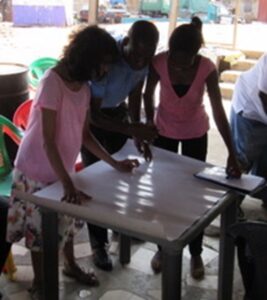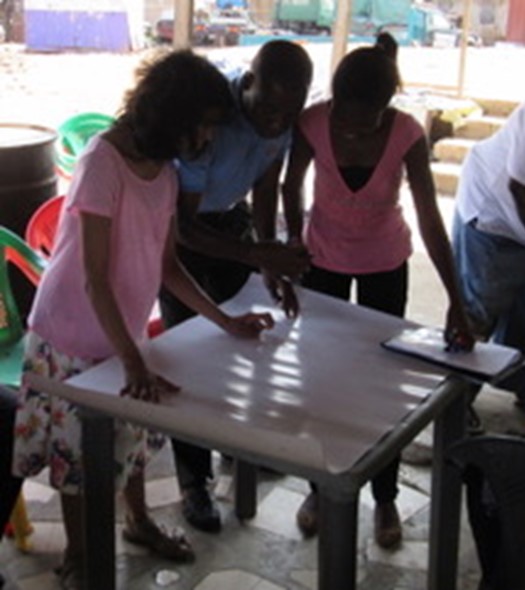Simplifying WASH terms for communities in the global South
By Brian Reed and Amita Bhakta

Photo: A. Sears
When working with anyone wherever they live, it is as important as ever that we are able to discuss the issues which they wish to be addressed by development professionals, in a way in which everyone can fully understand.
Development professionals know the importance of communicating with various stakeholders but putting theory into practice is not always straightforward. If you went to a medic and they spoke to you about the state of your phalanges, would you know what they were talking about? Could you distinguish between your proximal, intermediate or distal phalanges? Professionals do use specialist language so they can be precise about specific issues but these words and abbreviations can create confusion when used with people outside the profession. The words can convey whole concepts that cannot be simply summarized. Engineers working in sanitation tend not to use many complex words, but their terminology can still be precise. Do you know the differences between sewers, sewage and sewerage? Even within the engineering profession, terminology can be confusing. One example is the term “shared sanitation” – does this mean a toilet shared by people in the same house, the same neighbourhood, a community or the general public? The WASH sector does not just consist of engineers. For over 40 years, it has been made up of a range of professionals. Unlike health or education, there are a wide variety of career paths, with people coming from backgrounds in sociology, political science, physical and human geography and other fields. Each of those perspectives brings a different set of terminology with it. In a post-2015 era in which we are trying to ‘leave no-one behind’, terms such as “vulnerable groups, gender, lower-quintile, people with disabilities, disabled people, women, LGBT+, socially excluded, girl-child” overlap, divide, compete and confuse. Experts who do not have qualifications in engineering may not always understand the differences in various technical components of WASH but the same confusion can apply to the terminology of each career path.
A vital group of stakeholders are the users of WASH facilities and services. It is often hard to consider what terminology these people may be familiar with. Technical WASH professionals may be able to distinguish between a VIP, a pour-flush and a tiger worm toilet, but are the users familiar with the differences? Are they even aware that there are different types? They may have only seen the type of toilet they current use, so asking them what they use make no sense as a question. This is not just a problem with sanitation, as every professional has to consider their language. Do all car drivers know what type of engine their vehicle has? A social scientists’ role in WASH is often to work with communities, as they can have better communication skills than technical staff, but they also need to be able to communicate with the technical staff and speak knowledgably about the very facilities and services they are discussing.
How do we deal with this? Using the terms of the WHO/UNICEF Joint Monitoring Programme with communities across the global South simply does not work. We have to consider the people we are speaking with and start the conversation at their level. Even basic concepts such as the sanitation ladder or the F diagram are quite complex, so decide if they really are necessary. Explanations, examples and illustrations can help inform the dialogue but even pictures have to be relevant and understandable.
This is not just about using simpler words – although that is a good start. Just providing a definition of a word may not help if the idea behind it is not familiar. Communication needs to be tested, piloted and discussed to check that the questions are not only understood, but also relevant to the situation. Do listen to the respondent and adapt tools such as surveys accordingly. This means we need to lift our heads from the technical textbooks, policy documents and strategy statements, and convey these concepts in a local context. Exploring the local everyday terminology or descriptions for the ‘toilet’, ‘water source’ or ‘menstruation’- is a good place to start.
And how are your phalanges? – that’s finger and toe bones to most of us…
